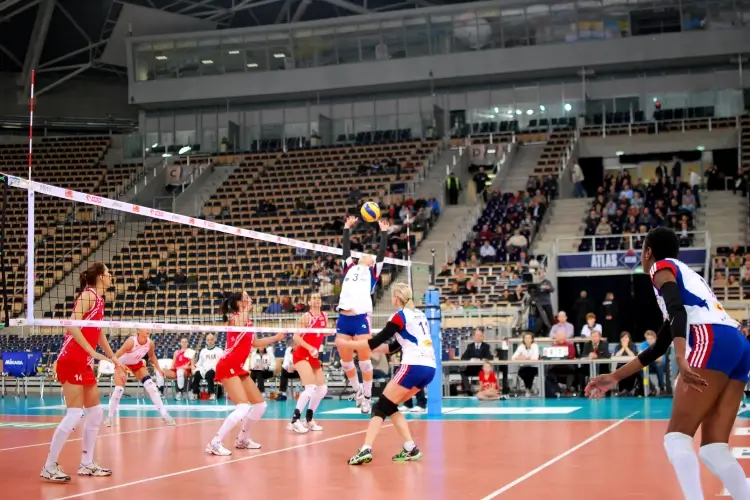Last Updated: January 16, 2024
No team will ignore a proficient setter. As a setter, you may want to keep improving yourself to be of great value to a team.
You should be capable enough to take any pass, good or bad, and convert it into an opportunity-scoring attack for your team. This is expected when you wish to excel at your sport.
Here are some tried and tested volleyball setting techniques that can help anyone with the mental desire to be the best volleyball player they can be.
Techniques to Improve Volleyball Setting Skills

Don’t use your hands
How you use your forearms, wrist, and fingers matter. It is, perhaps, a game-changer. Keep in mind that the ball should not touch your hands. You should be using only your fingers to set the ball. Your fingers can hurt, but only when you keep them too stiff.
Before playing, you should warm up your fingers with gentle exercises to prepare them for the game ahead.
Make a diamond
Setters usually touch the ball more often than other players on the team. So, learning the correct ball-handling skills is a must.
Attempt to make a diamond with the hands. Keep in mind that your hands should be wide enough to hold the ball. The setup should be such that if the ball misses your hands, it should smash your nose. Also, keep your wrists stiff, and do not hold the ball for longer than a second. A quick touch makes a difference.
Vary your sets
Take the time to practice different kinds of sets. Most proficient setters can do all sorts of sets, which makes them stand out from other setters. After you master the easier sets, learn the ones you probably don’t know, including quick sets, back sets, and shoots. Every new variation you learn will improve your team’s scoring chances by exploiting different areas of the opponent’s defense.
Keep your hands down
One easy tip to position yourself quickly under the ball is to move with your hands low and close to the body. If you move with your hands up, it will slow you down considerably. As a result, you will have a hard time covering a lot of ground.
Practice moving with your hands down and then quickly snap your hands in the ball receiving position once you are ready to connect with the ball. This will also help in sometimes deceiving the opponents as they won’t easily recognize your next move.
Take the ball over your forehead
Once the ball crosses the net, focus on taking the ball over your forehead. This is the most advantageous position to be in to minimize unwanted ball spin. It also helps to set the ball for various types of attack execution.
You will have to keep track of the ball throughout its journey as it travels towards you so that you can position yourself under the incoming ball at the right time. Once the ball is over your forehand, you will be in an ideal position to set the ball accurately.
Practice jumping drills
Increasing your jump height can be highly beneficial. So, work on your vertical leap by performing relevant drills like depth jumps, box jumps, squat jumps, and single-leg hops. To perfect your jump timing, practice jumps with your arms in the air.
Your wrist must be firm but flexible enough to guide the ball when its met in mid-air. Just warm up well before starting any jumping exercise.
Practice with a weighted ball
Incorporating weighted ball drills can fetch you great results over time. Including them in your training regime will help you with both skill and strength development.
You can start with a basic drill by using a light-weighted ball. Simply pass the ball back and forth to your partner while working on your setting technique. Once there is improvement, you can shift to a heavier ball.
Square up to the net
Mastering the skill of squaring up to the net is vital to becoming a proficient setter. When you face the net squarely, it puts you into an advantageous position for delivering accurate sets to the hitters for executing successful attacks. You will be able to set the ball at ideal spots, enabling the hitters to do their job well.
Related: Setting for Victory: Setting Strategies for Boosting Your Team’s Performance
This may sound like a simple advice. However, many players don’t adjust themselves to square up against the net, which eventually affects the team’s score.
Work on your communication skills
Experienced setters often act as court coaches. Therefore, it’s necessary for them to communicate well with the team. After all, good communication skills can make or break a team. A setter can communicate either verbally or through hand signals.
As a setter, you should portray a relaxed and confident attitude, even when you don’t feel like it. Sometimes, you may also have to take the blame for mishaps, even when it’s not your fault.
Work on your strength and endurance
While all the skill-learning is a must, it’s equally important to work on your strength and endurance to be better than before. Focus on developing your entire body, particularly your legs, shoulders, forearms, and core muscles. These muscles are extensively used during volleyball. So, you want them to be as strong as possible to get better while being less prone to injury.
Conclusion
A good setter can make a weak team a good team. On the other hand, a poor setter that makes mistakes often can do exactly the opposite. While you need to hone your volleyball skills, you should focus on mastering one thing at a time.
So, try not to fix everything at once. Even at the highest levels, players don’t risk overwhelming themselves. Pick something you can really focus on and then move to the next technique because doing multiple things simultaneously can do more harm than good.
At the same time, focus on the quality of the practice session as opposed to the quantity of the repetitions. Ideally, you should aim to execute the skills accurately rather than rushing through the process.
